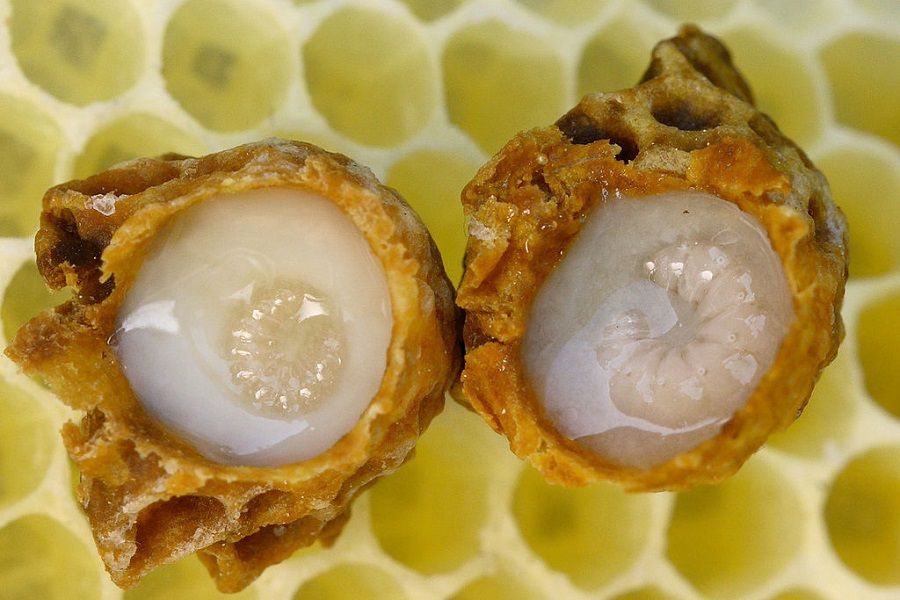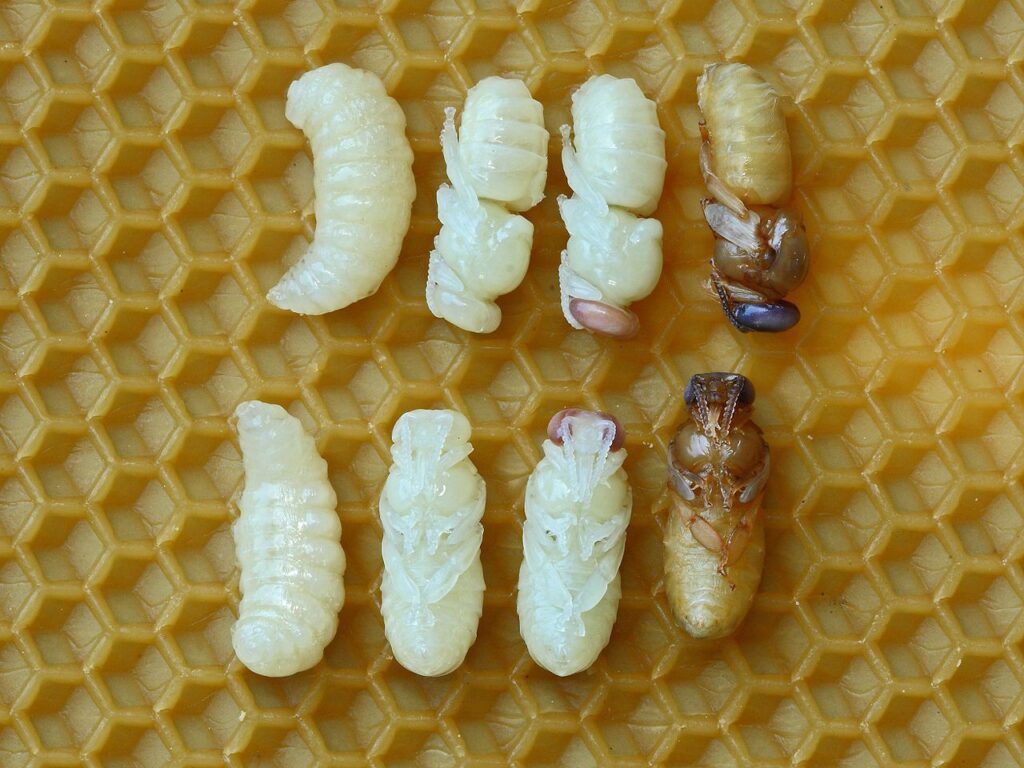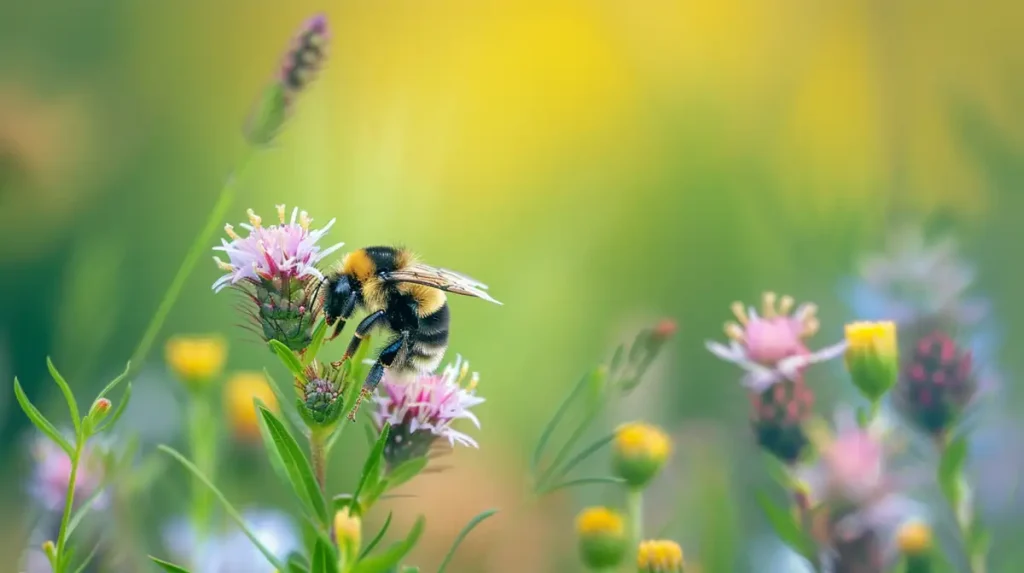Table of Contents
The honey bee life cycle consists of four stages: egg, larva, pupa, and adult. The queen lays eggs that hatch into larvae and are fed by nurse bees. The larvae spin a cocoon and enter the pupal stage. After metamorphosis, the bee becomes an adult and joins the colony. The cycle takes around 12-16 days, depending on the bee type.
In the below paragraphs, we will take a more detailed look at this topic.
There are four stages of the honey bee’s life cycle: egg, larva, pupa, and adult. There are also three different castes of honey bee, so how long each honey bee live depends on their caste. The queen bee can live for up to five years, while the worker bees live for about six weeks. Male drones die after mating with the queen.
The Stages of Development
Indeed, the primary role of male honey bees (known as drones) is to mate with the queen bee during mating flights. These flights typically occur far from the hive to ensure genetic diversity. During the mating flight the queen bee will mate with multiple drones (often up to twenty-four) in mid-air. This process is crucial for the continuation of the colony.
Unfortunately for them, the drones die shortly after releasing their sperm as their reproductive organs are torn away during the process. Their sole purpose in the hive is to reproduce; once they have fulfilled that purpose their life comes to an end.
After the mating flight, the now-fertilized queen bee returns to the hive, where she will begin the process of laying eggs. These eggs mark the first stage in the development of honey bees. The queen bee can lay thousands of eggs each day, ensuring the growth and survival of the colony. The fertilized eggs will develop into female worker bees while unfertilized eggs become male drones.
Stages of Honey Bee Egg Development
- Embryonic Stage (Days 1-3): During the first three days of development, the honey bee egg goes through the embryonic stage. In this phase, the nervous system, digestive system, and outer covering begin to form. The eggs are fragile and require the right temperature and humidity to ensure proper development.
- Larval Stage (Days 4-8): After the embryonic stage, the egg hatches into a larva. During the larval stage, the worker bees feed the larva a mixture of pollen, nectar, and royal jelly. The larva will go through several molts as it grows, eventually filling the cell.
- Pupal Stage (Days 9-20): The larva then spins a cocoon around itself and transforms into a pupa. Worker bees will cap the cell with beeswax, providing the developing bee with a secure environment to complete metamorphosis. The pupal stage is when the bee’s eyes, wings, and other adult features develop.
- Emergence (Days 21+): Once development is complete, the adult bee will chew through the wax capping and emerge from the cell. The time it takes for the egg to reach adulthood varies depending on the type of bee: worker bees typically emerge after 21 days, drones after 24 days, and new queens after 16 days.
Honey Bee Egg Development and the Queen’s Role
Honey bee eggs are minuscule, roughly the size of a grain of rice. They play a crucial role in the life cycle of the honey bee colony. The queen bee is the central figure in the egg-laying process, with the ability to lay up to three thousand eggs daily. The queen’s decision to lay fertilized or unfertilized eggs determines the gender of the offspring: fertilized eggs develop into female worker bees while unfertilized eggs become male drones. In this section, we’ll delve deeper into the egg-laying process, the development of honey bee eggs, and the different types of cells in which they are laid.
The Egg-Laying Process
The queen bee’s egg-laying process is critical to the colony’s success. The queen has a unique organ called the spermatheca, where she stores sperm from mating flights. This allows her to control the fertilization of eggs throughout her life. When laying an egg, she can choose to release sperm from the spermatheca to fertilize the egg or keep the sperm separate, resulting in an unfertilized egg.
Worker, Drone, and Queen Cells
The queen bee places fertilized eggs in smaller worker cells, which eventually develop into female worker bees. Unfertilized eggs are laid in larger drone cells, specifically designed to accommodate the larger size of male drones. Occasionally, the queen will lay a fertilized egg in a unique, vertically-oriented queen cell. The egg laid in a queen cell is also a female but it receives a special diet of royal jelly, which triggers the development of reproductive organs and allows it to become a future queen.

Larva Stage: A Critical Phase in Honey Bee Development
The larva stage is an essential part of the honey bee’s life cycle as it sets the stage for the future roles and responsibilities of each bee within the colony. This phase involves rapid growth and development as well as differentiation between queens, workers, and drones. This section will take a look at the larva stage and explore the intricacies of this critical period.
Rapid Growth and Molting
As mentioned, honey bee larvae grow at an astonishing rate, increasing in size more than 1,500 times in just five days. This rapid growth is facilitated by a process called molting, in which the larvae shed their outer skin (also known as an exoskeleton) five times. Molting allows the larvae to accommodate their expanding bodies and continue growing without being constrained by their previous exoskeleton.
Feeding and Nourishment
Nurse Bees: The Caretakers of the Hive
Nurse bees play an important part in the development of honey bee larvae as they are responsible for feeding and tending to the young bees. These female worker bees, typically between 3 and 12 days old, have well-developed hypopharyngeal glands that produce nutritious secretions to feed the larvae.
- Carter, Anthony (Author)
- English (Publication Language)
- 194 Pages - 02/28/2024 (Publication Date) - Independently published (Publisher)
A Thousand Meals a Day: The Larvae’s Voracious Appetite
Larvae have an insatiable appetite, consuming over a thousand meals a day. This high rate of feeding is necessary to support their rapid growth and development during this stage. To satisfy this demand, nurse bees work diligently to provide the appropriate nourishment for the larvae.
Royal Jelly vs. Bee Bread: The Dietary Differentiation
In the first few days, all larvae receive royal jelly, a nutrient-rich secretion produced by nurse bees. This substance contains essential proteins, vitamins, and lipids that promote healthy growth and development. However, only those larvae designated to become potential queens continue to receive royal jelly exclusively. The rest of the larvae destined to become worker or drone bees transition to a diet of bee bread, a mixture of pollen and honey. This dietary differentiation plays a significant role in determining the future roles of bees within the colony.
Sealing and Cocoon Formation
After five days of rapid growth and development, the larvae reach a stage where they are ready to transition into pupae. At this point, worker bees seal the larvae in their cells with a beeswax cap. Sealed within their cells, the larvae then spin themselves into cocoons, a protective layer that will serve as a shelter during the next phase of their development: the pupal stage.
Pupa Stage: A Critical Transformation Period in Honey Bee Development
The pupa stage is a vital phase in the life cycle of honey bees, as it marks a significant transformation from a larva into a fully developed adult bee. This metamorphosis process takes place within the safety of a capped cell, allowing the bee to develop undisturbed. In the below paragraphs I will delve into the various stages of the pupal development, discussing the different parts of the bee that form during this time as well as the timeline for this remarkable process.
The Pupal Development Process
The pupa stage commences once the larva has spun a cocoon around itself and the cell has been capped with beeswax by worker bees. It is during this phase that the bee’s body undergoes remarkable changes, forming the eyes, legs, wings, thorax, abdomen, and head. Let’s take a closer look at these developments:
- Eyes: The eyes are the first visible transformation, changing from pink to purple and finally to the familiar black color. The bee will develop two large compound eyes, which are essential for navigation and foraging, as well as three smaller ocelli on top of its head for detecting light.
- Legs: During the pupa stage the bee’s legs will form, allowing it to navigate and perform tasks within the hive or nest. Each bee has six legs, with the forelegs of worker bees possessing specialized structures called pollen baskets for collecting pollen.
- Wings: The wings develop during the pupal phase as well, and once fully formed the bee will have two pairs of membranous wings. These wings are crucial for flight, enabling the bee to forage for nectar and pollen as well as perform other essential tasks outside the hive.
- Thorax and Abdomen: The thorax houses the bee’s muscles for flight and leg movement while the abdomen contains the digestive, reproductive, and excretory organs. Both of these body segments take shape during the pupal stage.
- Head: The bee’s head forms during the pupal phase, housing important structures like the antennae, which are essential for detecting odors and sensing touch as well as the mouthparts for ingesting nectar and pollen.

Timeline of Pupal Development
The entire pupa stage typically takes around twelve days, though the exact duration can vary depending on factors such as temperature, humidity, and the specific caste of the bee (i.e., worker, drone, or queen). Here’s a rough timeline of the pupal development:
- Days 1-3: Eyes and antennae start to form
- Days 4-6: Wings, legs, and thorax begin to develop
- Days 7-9: Abdomen and head continue to take shape
- Days 10-12: Final development and maturation of internal organs.
Emergence of the Adult Bee
Once the pupa has fully developed into an adult bee, it is ready to chew its way through the beeswax cap and emerge into the hive or nest. Upon emergence, the bee will join the rest of the colony, taking on specific roles and responsibilities depending on its caste. For example, worker bees may engage in tasks such as foraging, tending to the brood, and maintaining the hive while drones will focus on mating with the queen.
Adult Stage: The Roles and Responsibilities of Honey Bees in the Hive
The adult stage in a honey bee’s life is when they assume their roles within the hive, carrying out various tasks to ensure the survival and success of the colony. During this stage, each caste – queen, worker, and drone – fulfills specific duties that are vital to the hive’s overall health and function. In this section, we’ll explore the responsibilities of each caste and how they contribute to the well-being of the colony.
Queen Bee: The Heart of the Hive
The queen bee is the sole reproductive female in the colony, responsible for laying all the eggs that will develop into new members of the hive. After her initial mating flight, during which she mates with multiple drones, the queen can lay up to 2,000 eggs per day during peak season. She is also responsible for releasing pheromones that maintain the colony’s cohesion and suppress the reproductive systems of worker bees.
Worker Bees: The Backbone of the Colony
Worker bees, which are all female, comprise the majority of the hive’s population. They perform a variety of tasks throughout their lives, based on their age and the needs of the colony. Some of the key roles they play include:
- Nurse Bees: Young worker bees, usually between three and twelve days old, take care of the brood by feeding and grooming larvae, as well as attending to the queen. They also produce royal jelly, which is fed to all larvae for the first few days and is the exclusive diet of queen bee larvae.
- House Bees: These bees maintain the cleanliness and structure of the hive. They build and repair honeycomb, remove debris, and regulate the hive’s temperature by fanning their wings to circulate air.
- Foragers: Older worker bees (typically around fifteen days or older) collect nectar, pollen, water, and propolis (a resin-like substance used in hive construction) from nearby plants. They transport these resources back to the hive, where they are processed and stored for future use.
- Guard Bees: These workers defend the hive from intruders such as wasps, hornets, and other bees. They use their stingers to protect the colony and release an alarm pheromone to alert other bees of potential danger.
Drone Bees: The Colony’s Genetic Contributors
Drone bees, the only males in the colony, have a singular purpose: to mate with virgin queens from other hives. They typically live in the hive until they are mature enough to fly and search for potential queens. Once a drone successfully mates with a queen, his life comes to an end as the act of mating is fatal for him. Drones that do not mate will usually be expelled from the hive during autumn, when resources become scarce.
Life Cycle of a Bee – Conclusion
In conclusion, the fascinating life cycle of honey bees, consisting of four stages – egg, larva, pupa, and adult – is marked by a complex division of labor among the queen, worker, and drone castes. Each bee plays a critical role in the colony’s survival and success, from the queen laying thousands of eggs, to the workers performing various tasks based on their age and the colony’s needs, and the drones focusing on mating to ensure genetic diversity. The resilience and adaptability of honey bees, combined with their intricate social structure, make them an essential part of our ecosystem, and understanding their life cycle offers valuable insights into their remarkable behavior and the integral role they play in pollination and food production.
Last update on 2024-04-25 / Affiliate links / Images from Amazon Product Advertising API



